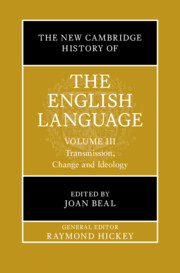Book contents
- The New Cambridge History of the English Language
- The New Cambridge History of the English Language
- The New Cambridge History of the English Language
- Copyright page
- Contents
- Figures
- Tables
- Contributors to Volume III
- General Preface
- Abbreviations
- General Editor’s Introduction
- Introduction to Volume III
- Part I The Transmission of English
- 1 Dictionaries in the History of English
- 2 Writing Grammars for English
- 3 Speech Representation in the History of English
- 4 Digital Interaction in the History of English
- 5 Internet Resources for the History of English
- Part II Tracking Change in the History of English
- Part III Ideology, Society and the History of English
- Index
- References
1 - Dictionaries in the History of English
from Part I - The Transmission of English
Published online by Cambridge University Press: 23 October 2025
- The New Cambridge History of the English Language
- The New Cambridge History of the English Language
- The New Cambridge History of the English Language
- Copyright page
- Contents
- Figures
- Tables
- Contributors to Volume III
- General Preface
- Abbreviations
- General Editor’s Introduction
- Introduction to Volume III
- Part I The Transmission of English
- 1 Dictionaries in the History of English
- 2 Writing Grammars for English
- 3 Speech Representation in the History of English
- 4 Digital Interaction in the History of English
- 5 Internet Resources for the History of English
- Part II Tracking Change in the History of English
- Part III Ideology, Society and the History of English
- Index
- References
Summary
This chapter gives an overview of dictionaries, broadly conceived to include monolingual and bilingual wordlists for readers at all levels, in the history of English from the beginnings of Anglo-Saxon literacy to the present day. It argues against a reductive view of dictionaries as primarily agents of standardisation and authority, expressions of the ‘dismal sacred word’. Its arrangement is roughly chronological, beginning with Anglo-Saxon glossography and the lexicography of later medieval English, before turning to the bilingual and monolingual English dictionaries of the early modern period; to the monolingual dictionaries of the eighteenth century; and to the relationship of lexicography to two very important aspects of Late Modern English, namely its pluricentricity and its use as an acquired language. It concludes with a last look at the relationship of English lexicography with the ‘dismal sacred word’.
Keywords
Information
- Type
- Chapter
- Information
- The New Cambridge History of the English LanguageTransmission, Change and Ideology, pp. 35 - 57Publisher: Cambridge University PressPrint publication year: 2025
References
Accessibility standard: WCAG 2.0 A
Why this information is here
This section outlines the accessibility features of this content - including support for screen readers, full keyboard navigation and high-contrast display options. This may not be relevant for you.Accessibility Information
Content Navigation
Allows you to navigate directly to chapters, sections, or non‐text items through a linked table of contents, reducing the need for extensive scrolling.
Provides an interactive index, letting you go straight to where a term or subject appears in the text without manual searching.
Reading Order & Textual Equivalents
You will encounter all content (including footnotes, captions, etc.) in a clear, sequential flow, making it easier to follow with assistive tools like screen readers.
You get concise descriptions (for images, charts, or media clips), ensuring you do not miss crucial information when visual or audio elements are not accessible.
You get more than just short alt text: you have comprehensive text equivalents, transcripts, captions, or audio descriptions for substantial non‐text content, which is especially helpful for complex visuals or multimedia.
Visual Accessibility
You will still understand key ideas or prompts without relying solely on colour, which is especially helpful if you have colour vision deficiencies.
Structural and Technical Features
You gain clarity from ARIA (Accessible Rich Internet Applications) roles and attributes, as they help assistive technologies interpret how each part of the content functions.
